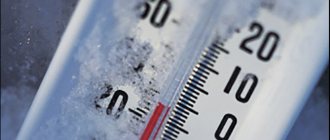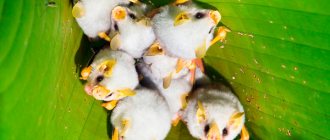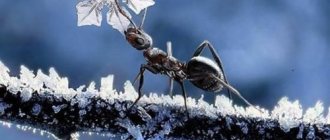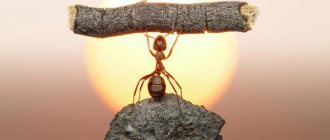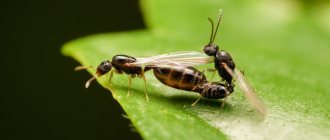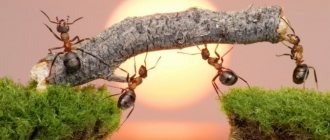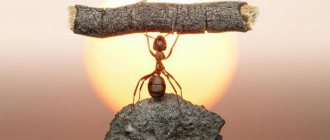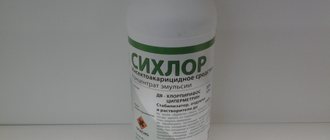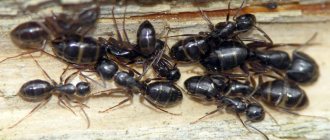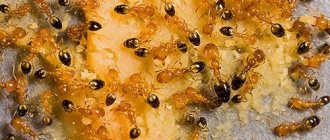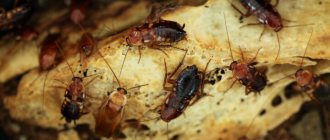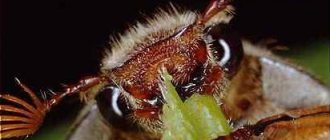Everyone has known ants since childhood. These creatures are characterized by labor-intensive abilities, thanks to which they carry objects many times the weight of their own body.
Also, many people know about the omnivorous nature of individuals living in natural conditions (forests, fields, vegetable gardens), as well as parasites that settle in human homes. Household pests are especially adapted to different types of food, making them quite difficult to eliminate.
Even if the apartment is kept perfectly clean, some housewives may find these insects in their kitchen and other rooms of the apartment. To understand the essence of behavior and survival of ants in different environmental conditions, you should understand what they prefer to eat in nature and at home.
Ant diet
Depending on the species, habitat and time of year, the menu of ants may vary. Even strict vegetarians, like harvester ants, change their preferences when they get into the house. For this reason, what ants eat in nature is very different from their gastronomic preferences in the apartment.
On a note!
Most ants are divided by type of food: larvae and queens feed on protein foods, workers eat easily digestible carbohydrates.
Ants often drink “honeydew” - the sweet juice of a plant that is released when there is a sharp change in air temperature.
Ant food
Ant predator food
The diet of predator ants consists exclusively of animal food, which they also feed their offspring.
The main food for them is:
- small insects;
- invertebrate larvae;
- small lizards;
- frogs;
- sick chicks.
In addition, predatory ants feed on rotting corpses of animals encountered along their route, as well as on wounded immobilized animals.
Woodworms: what do they eat?
The food of wood borers is the rotten pith of dead trees. Adult woodworms can feed on such rough food due to the presence of bacteria in their intestines that help digest cellulose. By eating rotting trees in the forest, woodworms bring significant benefits.
On a note!
But these same insects in log houses can eat the core of the walls and build an anthill there. When woodworms appear in the house, it is better to take measures to exterminate them.
Eating in the wild
The main diet in the wild depends on the type of ant. For example, forest individuals living in a temperate continental climate feed on the seeds of various plants, corn, rice, wheat and other cereals. They are not averse to eating invertebrates, insects, and larvae. At the same time, some individuals do not consume more than 2 types of foods:
- Reaper Ants . This is the friendliest type of ant. The main food they consume is grass seeds and grains. Such food is solid and the inhabitants of the anthill cannot consume it whole, so the reaper insects, with their powerful jaws, process it into a porridge-like substance. And only then are they handed over to the rest of the ants to be eaten. In addition to grains, they love to eat plant fruits.
- Carpenter ants . Insects build anthills in fallen trees and rotten stumps. They chew out huge, long labyrinths in them. Tree resins (gum) that are released from damaged bark, as well as the bark itself, become their main source of nutrition. A special intestinal bacterium helps digest hard foods. Sometimes woodworms attack wooden houses, making nests inside logs, which causes particular concern to humans.
- Leaf cutters . Despite its name, this type of ant does not consume plants. They collect leaves, chew them into a homogeneous substance, store them in one place, and then grow mushrooms there, which they eat. To prevent the mycelium from growing too much, the mushroom body is periodically removed.
- Ponerins . This is a huge subfamily of active ants. Their diet consists of various forest pests, and each species from the subfamily eats a specific insect. These are irreplaceable ants, which are considered forest orderlies.
- Ant-Dracula . Adult ants catch various insects, in particular centipedes and spiders, then feed them to their larvae and drink their juice, which they reproduce.
- Centromyrmex . Carnivores that eat meat. Ants feed only on termites, so they live in areas where these insects live. Centromexes do not live in our country. They can only be found in private collections or in a museum, as an exhibit.
How to get rid of flying ants
Forest ants are dangerous with their bites. When bitten, acid is released, which can cause allergies. The wound turns red, itches very much, and swells. In small quantities the substance is not dangerous and after a while the swelling goes away. With multiple bites, people prone to allergies may experience dizziness and nausea. In some cases, the face swells, blood pressure rises, and speech disappears.
Predatory species
Most ants living in the tropics and subtropics are predators. Their diet is varied:
- Stray ants are among the most dangerous insects of the ant family on earth. They are also known as nomads. They require exclusively protein food, these are: mice, birds, lizards and various small animals, which they eat alive. Insects do not even pass by the corpses of large animals. Some individuals engage in cannibalism.
- Bulldogs are predatory individuals that attack small insects, wasps and spiders. Adult ants feed the larvae with the prey they catch, and they themselves feed only on fruits and plants. They differ from other species in that the female not only gives birth to offspring, but also goes hunting herself.
- Fire ants can be beneficial to humans. They eat insect pests of agricultural crops. In sugar cane, ants reduce the number of moths; in cotton fields, they destroy weevils that eat cotton. Sometimes they attack their brothers, driving them out of the territory. Ants also eat the laid eggs of small amphibians. Because of this, amphibians have to change their morphology.
Scientists who studied ants found that they eat according to a strict system, although their diet includes a variety of foods. They carefully select their food and with this behavior are very similar to humans.
Garden pests and their bugs
One of the serious enemies of gardeners is the black garden ant. The species is omnivorous, but if given a choice, ants eat the sweet secretions of aphids. If there are no aphids in the garden, the “shepherds” will carefully bring them with them, because ants and aphids live in close symbiosis. Pests collect the honeydew and take it to an anthill, which they set up in any place convenient for them:
- soil;
- old stump;
- wall of the house;
- in the crack under the window sill.
In the last two cases, they enter the house. In the house, garden ants eat everything they can find, justifying their omnivory. Having found sweet food: sugar or honey, the garden pest will drag it into the anthill. In the garden, they can also not only breed aphids, but also harm plants. According to gardeners, representatives of the “black garden” species feed on young cabbage seedlings in the spring. Climbing into the hives for honey, these insects harm beekeepers.
Food for ants
Lifestyle and house structure of an ant family
Ants are social insects. They live as a large family, in which everyone has their own responsibilities. He receives them before birth, since the eggs and larvae of working individuals and the court retinue are laid and raised differently. The nutrition of the ants also depends on the future destination.
The uniqueness of a family with several thousand of its members lies in the fact that 3 genders are represented in the nest: he, she, it.
There are 3 genders in an ant's nest: he, she, it
The queen never leaves her nest and lays eggs. In some families there may be several. They live the longest unless they die from the clutches of their relatives. The name of the queen as a queen is not correct, since she does not lead anyone. On the contrary, its fate depends on the decision of the worker ants. To fertilize the queen, there are several males who also live in the burrow with the queen. The bulk are hard workers, warriors and the people who feed everyone and decide everything, asexual insects, those same ones.
The reproductive organs of worker ants have degenerated into a sting, which they use to protect themselves from enemies and kill small prey.
What do ants eat and what does it depend on? Insects consume protein foods, which give strength and rapid growth, and easily digestible carbohydrate foods:
- carbohydrate adults;
- protein queen and larvae.
Ants consume protein foods, which give strength and rapid growth, and easily digestible carbohydrate foods.
Worker ants live 1–3 years. Males with a queen die a few days after mating. When the queen begins to perform poorly in her duties, the workers lay a series of female larvae and kill the only female in the family, and then the inhabitants of the nest eat her.
Asexual individuals make up the bulk of the anthill. They get food and take it to the nest to feed future ants. They keep and feed the queen and her retinue for reproduction.
Forest ants
Red forest ants are fairly harmless creatures.
On a note!
This species is sometimes called red forest.
Their anthill is always in the forest. They crawl into the house only in search of food if the housing is located near an anthill. In nature, forest ants feed on:
- caterpillars;
- seeds;
- aphid honeydew;
- honey dew;
- fruits of plants.
Who eats ants?
Many animals eat ants. Bears love to destroy the anthill, getting to the larvae of forest ants. Often anthills and wild boars are torn apart. Frogs, toads, wasps, lizards, antlions (insects of the order Netoptera), moles and hedgehogs eat ants of various types, including those living in the ground and trees.
Many birds value ants for their taste and nutritional qualities. Woodpeckers are especially active in destroying these insects, and during the swarming period (when the ants develop wings), they are attacked by swallows, swifts and dragonflies.
In warm countries, the natural enemies of ants are anteaters, aardvarks and armadillos, as well as some tribes of people who eat insects and their larvae as food. Some species of ants are attacked by other ants, and in times of famine, ants of the same species can eat each other.
On video: Ants drag sausage.
Pharaoh ant
Food for the ant
A species that has become completely at home with humans over the course of two centuries. The diet of pharaoh ants is no different from the human diet. Under natural conditions, indoor pests feed on the same things that their red-haired counterparts eat in the forest:
- plants' seeds;
- small invertebrates;
- insects and larvae.
But in the house these parasites become a real disaster. Their diet is expanding significantly. Foods that ants eat at home:
- bread;
- sugar;
- potato;
- cereals;
- oil;
- cheese;
- meat;
- sausage;
- sweets.
Naming what they don’t eat is much easier than listing everything that these insects eat. They are especially attracted to sweets as food. They are quite capable of eating only sweets, cookies, pastries and cakes.
At home, almost all types of ants become omnivores and feed on the same food as humans.
Now information about which ants prefer what:
1. Formica rufibarbis: Points: 3 (everyone eats
